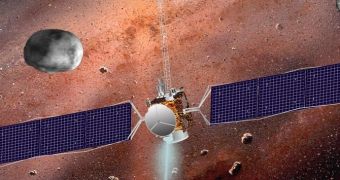The Dawn spacecraft, a NASA mission to the main asteroid belt, recently shut down its ion engines, according to the schedule, NASA officials announced. The three top notch propulsion systems may be switched on again in January in order to adjust the craft's orbit as it will near Mars, its first target during the long trek. Later, in June, a similar action will take the probe towards the Vesta asteroid in the belt, and, for the last part, the engines will be powered up again to take Dawn to the dwarf planet Ceres.
The main asteroid belt, named so in order to distinguish it from the Kuiper belt found at the edge of our solar system, is located between the orbits of Mars and Jupiter. Vesta and Ceres, Dawn's most important targets, are among the largest objects in the belt. The entire distance that Dawn will travel sums up 3 billion miles (4.9 billion kilometers). The spacecraft was launched last year and will reach its destination seven years from now, in 2015.
A quick calculation tells us that the average speed (without taking into account the stops it will make along the way) is nearly 12.5 miles (20 kilometers) per second and even higher. Vesta will be visited in 2011, on the way to Ceres. Dawn will perform shape, surface topography, elemental and mineral composition, tectonic activity history, mass and gravity field measurements, while also searching for evidence of water.
Ion propulsion systems are designed to gradually increase the speed of a spacecraft over long periods of time. The process uses about 0.26 kilograms (nearly 9 ounces - less than a can of soda) of xenon daily, and the engines will be fired up for a total of 50,000 hours (5.7 years) during the mission.
"Dawn will now coast in its orbit around the sun for the next half a year before we again fire up the ion propulsion system to continue our journey to the asteroid belt," explained Marc Rayman, the chief engineer for the Dawn spacecraft from NASA's Jet Propulsion Laboratory in Pasadena, California, quoted by Space.

 14 DAY TRIAL //
14 DAY TRIAL //